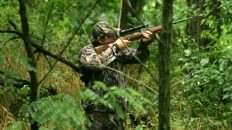Working livestock on a large property can be a hard way to make a living. Thick scrub, rough terrain, long distances and wandering animals (wanted and unwanted) are a reality of life. Often enough, farmers, pest controllers and animal handlers need a compact, light, reliable repeating firearm to deal with the challenges of sick livestock and packs of feral pests.
You’re quickly dismounting from a quad, a bike or a horse. Drawing a pistol will be quick during the narrow window of opportunity to act. This beats trying to ready a long arm, which would take crucial additional seconds or minutes, by which time the opportunity for action has passed.
Recent reports indicate that the Queensland Police Service Weapons Licensing Branch (the Branch) has decided to refuse a number of applications and renewals for primary producers to use pistols to do their job.
This has been disruptive to law-abiding shooters who already owned pistols for destroying livestock or pest animals in what are often challenging circumstances. The Queensland Tribunal that hears appeals against Branch decisions has found pistols to be perfectly suitable where the circumstances of the farm require them (see Harm v Queensland Police Service [2010] QCAT 518).
What the ‘Firearm Police’ say
In recent correspondence, the Branch has claimed that a CSIRO-published report and recommendations on feral pest destruction does not support the use of pistols in pest destruction. Appendix 2 to the CSIRO report lists various rifle ammunition and does not mention pistols or pistol ammunition.
Relying on the little that the CSIRO report had to say, one member of the Branch recently wrote:“[this] make[s] it virtually impossible to justify the use of concealable firearms to kill animals.”
This same claim was also made by the Branch a couple of years ago in a Tribunal appeal. Tribunal Member Howard considered this and wrote (in Shaxson v Queensland Police Service, Weapons Licensing Branch [2014] QCAT 309):
“Another document [offered by the Branch] entitled Model Practice for the “Welfare of Animals Feral Livestock Animals” published by the Standing Committee on Agriculture, Animal and Health Committee, SCARM Report 34, provides some potentially inconsistent information about humane destruction. It variously describes shooting as the most humane method of killing and refers to use of a pistol (although it seems only for recumbent animals), but later, sets out a schedule for firearms apparently recommended for various types of feral animals (these appear to be mainly, if not all, rifles and shotguns) …
The information provided in … Report 34 is general and untested. Therefore, I am wary of placing undue weight on it. […] although it appears to have some internal inconsistency does not deal with feral dogs particularly, and generally seems to support use of rifles and shotguns in management of feral animals.”
The Report claims that “The following schedule of firearms and ammunition has been prepared after consultation with State/Territory officers experienced in feral animal control”. It then lists ammunitions for rifles and shotguns.
On 7 July, I wrote to a long standing, PhD-qualified member of the NSW Department of Primary Industries (DPI), who I understand was involved in the preparation of these recommendations. I asked him what this consultation involved. I’ve received no response.
On 8 August, the CSIRO wrote back to me about my Freedom of Information (FOI) request for all documents relevant to the consultation. They advised: “Despite an extensive search, CSIRO has been unable to locate any document relevant to your request.”
“Impossible to justify the use of concealable firearms to kills animals”
On 19 December 2015, the police from the Stanthorpe Station and the local RSPCA attended a wallaby who’d been hit by a car and had a smashed leg. They weren’t taking statement from the wallaby. The policeman, a firearms instructor, fired six times to euthanise the macropod.
Senior Sergeant Mark Ireland said “it was fairly common for police to be called out to assist wildlife carers.”
The Police are well prepared. Documents obtained under the Queensland Right To Information (RTI) Act reveal that in October 2000, the Police and the Queensland DPI tested the Police service pistol at“distances ranging from 2 to 7 meters” against “actual cattle heads obtained from a local abattoir”. The documents tell us:
Inevitably police officers encounter situations where livestock are injured or maimed to the extent that they humanely destroyed. […]
The trial is to provide QPS with informed and tested technical information regarding humane destruction of livestock using the standard issue Glock 22 .40 Calibre. […]
You can imagine the expert heads nodding in unison at this paragraph:
“This projectile has mushroomed exceptionally well with the metal jacket peeling back to the gullet base resulting in increased diameter of the projectile on exit. This is a very desirable characteristic for a projectile for humane destruction purposes.”
It turns out that pistols are convenient tools in humanely destroying animals. So useful, in fact, that the Queensland Police sanction the use of pistols by their members for this purpose.
Three questions for the Firearm Police
- Is it possible that the codes of animal welfare are really more concerned with a humane destruction of an animal than with the barrel length of the firearm used to do it?
- If codes of animal welfare mean it is “virtually impossible” to justify using pistols to humane destroy animals: why do the Police do it so frequently given they have modern 5.56mm rifles at their disposal?
- Is it possible that pistols can be very convenient and that quick, multiple shots are OK to ensure suffering animals are humanely destroyed?






Add comment